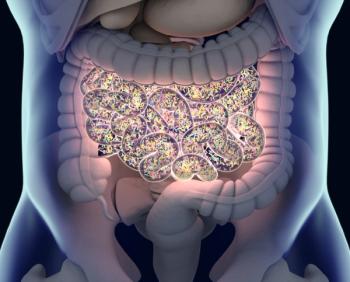
Nivolumab Plus Chemo Results in Higher Rates of OS and PFS
In the overall population and in patients with a PD-L1 CPS of 5 or greater who received nivolumab plus chemotherapy, overall survival and progression-free survival improved when compared with chemotherapy alone.
Nivolumab (Opdivo) in combination with chemotherapy produced a clinically meaningful improvement in overall survival (OS) and progression-free survival (PFS) in patients with previously untreated advanced or metastatic gastric cancer, gastroesophageal junction cancer, or esophageal adenocarcinoma when compared with chemotherapy treatment alone, according to a 4-year follow up of the phase 3 CheckMate 649 study (NCT02872116) presented at the
The median OS in the overall population was 13.7 months (95% CI, 12.4-14.5) in the combination arm and 11.6 months (95% CI, 10.9-12.5) in the monotherapy arm (HR, 0.79; 95% CI, 0.71-0.88). In patients with a PD-L1 combined positive score (CPS) of 5 or greater, the median OS was 14.4 months (95% CI, 13.1-16.2) in the combination arm and 11.1 months (95% CI, 10.1-12.1) in the monotherapy arm (HR, 0.70; 95% CI, 0.61-0.81). In patients with a PD-L1 CPS of 1 or greater, the median OS was 13.8 months (95% CI, 12.4-14.8) in the combination arm and 11.4 months (95% CI, 10.7-12.3) in the monotherapy arm (HR, 0.75; 95% CI, 0.67-0.85).
The median PFS in the overall population was 7.7 months (95% CI, 7.1-8.6) in the combination arm and 6.9 months (95% CI, 6.7-7.2) in the monotherapy arm (HR, 0.80; 95% CI, 0.71-0.89). In patients with a PD-L1 CPS of 5 or greater, the median PFS was 8.3 months (95% CI, 7.0-9.3) in the combination arm and 6.1 months (95% CI, 5.6-6.9) in the monotherapy arm (HR, 0.71; 95% CI, 0.61-0.82). In patients with a PD-L1 CPS of 1 or greater, the median PFS was 7.5 months (95% CI, 7.0-8.4) in the combination arm and 6.9 months (95% CI, 6.2-7.1) in the monotherapy arm (HR, 0.77; 95% CI, 0.68-0.88).
“[Nivolumab] is the first PD-1 inhibitor plus chemotherapy combination to demonstrate long-term efficacy vs chemotherapy and acceptable safety after 4 years of follow-up in patients with previously untreated advanced [gastric cancer, gastroesophageal junction cancer, or esophageal adenocarcinoma],” Kohei Shitara, MD, medical oncologist and the chief of the Department of Gastrointestinal Oncology of the National Cancer Center Hospital East in Kashiwa, Japan, and lead study author, said during the presentation.
This randomized, open-label, global, phase 3 study included a total of 2031 patients, 789 of whom were in the nivolumab plus chemotherapy arm and 792 of whom were in the chemotherapy alone arm. Patients were randomized 1:1:1 to receive either nivolumab at 360 mg plus XELOX every 3 weeks or nivolumab at 240 mg plus FOLFOX every 2 weeks, XELOX every three weeks or FOLFOX every 2 weeks alone, or nivolumab at 1 mg/kg plus IPI at 3 mg/kg every 3 weeks for 4 doses, then 240 mg of nivolumab. The trial only focused on the first 2 arms.
The median age of patients enrolled in each arm was 62 and 61, respectively. Most of the population were male (68% vs 71%), had an ECOG performance status of 1 (58% vs 57%), had gastric cancer at initial diagnosis (70% vs 70%), had metastatic disease (96% vs 95%), and had microsatellite stability (88% vs 86%).
Patients with previously untreated, unresectable advanced or metastatic gastric cancer, gastroesophageal junction cancer, or esophageal adenocarcinoma with no known HER2-positive status and an ECOG performance status of 0 or 1 were eligible to enroll on trial. Patients were stratified based on tumor cell PD-L1 expression, region, ECOG performance status, and type of chemotherapy received.
Primary end points included OS and PFS in patients with PD-L1 CPS of 5 or more. Secondary end points were OS and PFS in all patients and in patients with PD-L1 CPS of 1 or greater and 10 or greater, as well as overall response rate (ORR). Other exploratory end points included safety and quality of life.
At the data cutoff, the minimum follow-up was 48.1 months. Three patients in the combination arm and 9 in the chemotherapy arm were still receiving treatment at cutoff.
ORR in the total population was 58% (54%-62%) in the combination arm and 46% (95% CI, 42%-50%) in the monotherapy arm, with most patients experiencing a partial response (47% vs 39%), as well as complete responses (11% vs 7%) and stable disease (28% vs 33%).
The median duration of response (DOR) in the overall population was 8.5 months (95% CI, 7.7-9.9) and 6.9 months (95% CI, 5.9-7.6) in each respective arm.
ORR in patients with PD-L1 CPS of 5 or greater was 60% (95% CI, 55%-65%) in the combination arm and 45% (95% CI, 40%-50%) in the monotherapy arm, with most patients experiencing a partial response (47% vs 38%), as well as complete responses (14% vs 8%) and stable disease (28% vs 34%).
DOR in this population was 9.6 months (95% CI, 8.3-12.4) and 7.0 months (95% CI, 5.7-8.0) in each respective arm.
No new safety signals were reported. Any grade treatment-related adverse effects (TRAEs) occurred in 95% of patients in the combination arm and 89% of patients in the monotherapy arm. TRAEs leading to discontinuation occurred in 42% and 26% of patients in each respective arm, with 19% and 10% in each arm resulting from grade 3/4 TRAEs.
The most common grade 3/4 TRAEs in the combination arm included neutropenia (16%), decreased neutrophil count (11%), anemia (6%), and increased lipase (6%). In the monotherapy arm, the most common grade 3/4 TRAEs included neutropenia (13%), decreased neutrophil count (9%), diarrhea (3%), peripheral neuropathy (3%), anemia (3%), and vomiting (3%). A total of 16 patients in the combination arm and 4 patients in the monotherapy arm experienced treatment-related deaths.
Reference
Shitara K, Moehler M, Ajani, J, et al. Nivolumab (NIVO) + chemotherapy (chemo) vs chemo as first-line (1L) treatment for advanced gastric cancer/gastroesophageal junction cancer/esophageal adenocarcinoma (GC/GEJC/EAC): 4 year (yr) follow-up of CheckMate 649. Presented at the 2024 Gastrointestinal Cancers Symposium; San Francisco, CA, January 18-20, 2024. Poster 306.
Newsletter
Stay up to date on recent advances in the multidisciplinary approach to cancer.






























































































